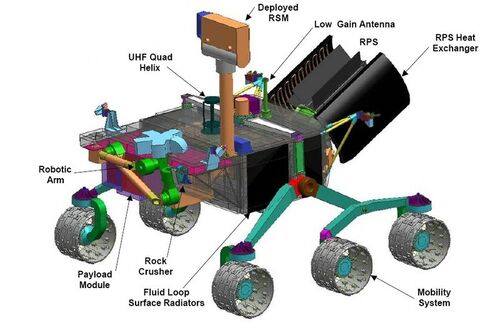Curiosity is NASA's car-sized rover that is currently exploring Mars, for the purpose of finding evidence supporting that life existed on

this planet. One of the primary goals of this misson is to search for and characterize a wide range of rocks and soils that hold clues to past water activity on Mars. It was launched from Cape Canaveral on November 26, 2011. It landed on August 5, 2012, with a complex landing procedure, using a large supersonic parachute and a skycrane to lower the rover down to the surface. Its mission was intended for two years, but has now been increased to indefinitely. It is one of the two active rovers, along with Opportunity.
Landing[]
Curiosity landed in Quad 51 of Aeolis Palus in Gale Crater. Gale crater, an estimated 3.5 to 3.8 billion-year-old impact crater, is hypothesized to have first been gradually filled in by sediments; first water-deposited, and then wind-deposited, possibly until it was completely covered. Wind erosion then scoured out the sediments, leaving an isolated 5.5-kilometer-high (3.4 mi) mountain, Aeolis Mons ("Mount Sharp"), at the center of the 154 km (96 mi) wide crater. Thus, it is believed that the rover may have the opportunity to study two billion years of Martian history in the sediments exposed in the mountain. Additionally, its landing site is near an alluvial fan, which is hypothesized to be the result of a flow of ground water, either before the deposition of the eroded sediments or else in relatively recent geologic history. An estimated 20,000 to 40,000 heat-resistant bacterial spores were on Curiosity at launch, and as much as 1,000 times that number may not have been counted.
Scientific Instruments[]
- Panoramic Camera (Pancam): for determining the mineralogy, texture, and structure of the local terrain.

- Miniature Thermal Emission Spectrometer (Mini-TES): for identifying promising rocks and soils for closer examination and for determining the processes that formed Martian rocks. The instrument is designed to look skyward to provide temperature profiles of the Martian atmosphere.
- Mössbauer Spectrometer (MB): for close-up investigations of the mineralogy of iron-bearing rocks and soils.
- Alpha Particle X-Ray Spectrometer (APXS): for close-up analysis of the abundances of elements that make up rocks and soils.
- Magnets: for collecting magnetic dust particles. The Mössbauer Spectrometer and the Alpha Particle X-ray Spectrometer are designed to analyze the particles collected and help determine the ratio of magnetic particles to non-magnetic particles. They can also analyze the composition of magnetic minerals in airborne dust and rocks that have been ground by the Rock Abrasion Tool.
- Microscopic Imager (MI): for obtaining close-up, high-resolution images of rocks and soils.
- Rock Abrasion Tool (RAT): for removing dusty and weathered rock surfaces and exposing fresh material for examination by instruments onboard.